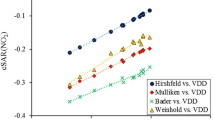Conclusions
-
1.
Calculations of the energy of the reaction, the characteristics of the electron distribution, and an analysis of the triplet instability of the RHF solution in the reaction of benzene, furan, and pyrrole with the electrophilic particles H+, F+, Cl+, Br+, NO2 +, and CH3 + in the starting stage of electrophilic substitution were performed by the method of SCF MO LCAO in the CNDO/2 approximation in the formalism of the restricted (RHF) and unrestricted Hartree-Fock (UHF) method.
-
2.
Based on an analysis of the zone of the triplet instability of the RHF solution, it was shown that the observed characteristics of the activity, positional and substrate selectivity of aromatic and heteroaromatic molecules begins to be established in the zone of electron transfer from the substrate to the electrophilic reagent with distances between reagents of less than 2.5 Å.
-
3.
The effect of a polar solvent on the parameters of the electron transfer zone was analyzed. It was shown that electron transfer is possible in the attack of benzene by H+, F+, and NO2 + particles and in attack of furan and pyrrole by H+, F+, Cl+, and N02 cations in this case.
Similar content being viewed by others
Literature cited
S. Fukuzumi and J. K. Kochi, J. Am. Chem. Soc.,103, 7240 (1981).
S. Nagakura, Tetrahedron, Suppl. 2, 361 (1963).
T. Takabe, K. Takenaka, K. Yamaguchi, and T. Fueno, Chem. Phys. Lett.,44, 65 (1976).
H. Fukutome, Progr. Theor. Phys.,47, 1156 (1972).
H. Fukutome, Progr. Theor. Phys.,49, 22 (1973).
J. Cizek and J. Puldus, J. Chem. Phys., 3976 (1966).
J. Puldus and J. Cizek, J. Polym. Sci.,29C, 196 (1970).
L. G. Gorb, I. A. Abronin, N. I. Kharchevnikova, and G. M. Zhidomirov, Zh. Fiz. Khim.,58, 9 (1984).
L. I. Belen'kii and I. A. Abronin, Zh. Org. Khim.,17, 1129 (1981).
A. Gordon and R. Ford, Chemist's Companion. A Handbook of Practical Data, Techniques, and References, Wiley (1973).
K. Yamaguchi and T. Fueno, Chem. Phys. Lett.,22, 461 (1973).
V. K. Potapov, Usp. Khim.,39, 2078 (1970).
T. Takabe and K. Yamaguchi, Chem. Phys. Lett.,40 347 (1976).
I. A. Abronin, G. M. Zhidomirov, and Ya. L. Gol'dfarb, Dokl. Akad. Nauk SSSR,218, 363 (1974).
N. D. Chuvylkin and B. I. Mokrousov, Zh. Fiz. Khim.,54, 545 (1980).
C. L. Perrin, J. Am. Chem. Soc.,99 5516 (1977).
Author information
Authors and Affiliations
Additional information
Translated from Izvestiya Akademii Nauk SSSR, Seriya Khimicheskaya, No. 5, pp, 1079–1085, May, 1984.
Rights and permissions
About this article
Cite this article
Gorb, L.G., Abronin, I.A., Korsunov, V.A. et al. Role of charge transfer in aromatic electrophilic substitution reactions. Russ Chem Bull 33, 991–996 (1984). https://doi.org/10.1007/BF01141711
Received:
Issue Date:
DOI: https://doi.org/10.1007/BF01141711




